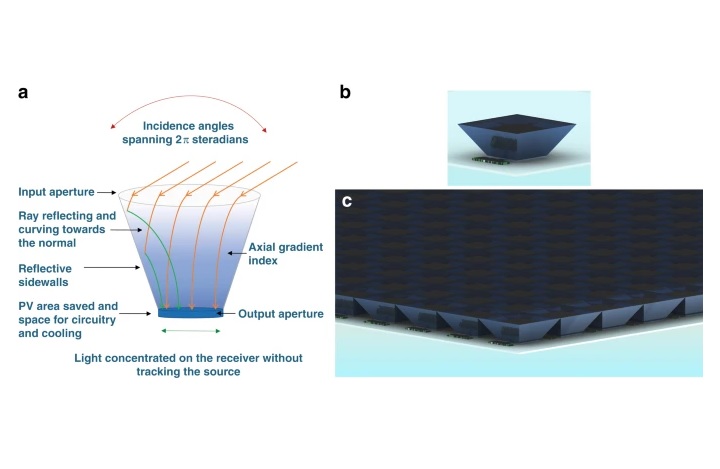Researchers designed, tested, and conceptualized a lens device that could efficiently collect light from all angles and focus it at a fixed output location. These graded index optics can also be used in light management, laser couplers, display technology, and other areas that improve coupling or resolution.
Solar panels are most effective when the sun hits them directly. Many solar arrays are designed to actively rotate in the direction of the sun, so that they capture as much energy possible. These arrays are more efficient than stationary systems, but they are also more costly and more difficult to maintain and build.
In the future, these active systems may no longer be required. Nina Vaidya, an engineering researcher at Stanford University, designed an elegant device that can gather and concentrate light falling on it. It does this regardless of its angle or frequency. The July issue Microsystems and Nanoengineering features a paper that describes the system’s performance and the theory behind them. Written by Vaidya, her doctoral advisor Olav Solgaard and professor of electrical engineering at Stanford, it is the cover story.
Vaidya is an assistant professor at University of Southampton in the UK. Concentrating light is much easier when there’s no optical focus that can move positions or requires tracking systems.
Researchers call the device AGILE, an acronym for Axially Graded Index Lens. It is very simple. It appears like an upside-down pyramid, with the point cut off. The square, tile-able top lets light in from all angles. It is then funneled down to create brighter spots at the output.

The researchers created prototypes that could capture more than 90% of the sunlight that hits the surface. They also managed to create spots at the output three times brighter that the incoming light. They could be installed on top of solar cell arrays to make them more efficient. They can also capture diffuse light scattered by the Earth’s atmosphere and weather.
The top layer of AGILE could be used to replace the current encapsulation protecting solar arrays. It would also allow for cooling and circuitry to run between narrowing pyramids of individual devices. This would reduce the area of solar cells required to produce energy and reduce costs. An AGILE layer can be used to protect solar arrays from radiation and concentrate sunlight without the need for solar tracking.
Imagine the Perfect Agile
AGILE’s basic concept is similar to using a magnifying lens to see the spots on leaves during a sunny day. The magnifying glass’s lens focuses the sun’s rays onto a smaller, brighter spot. The focal point of a magnifying lens moves with the sun. Solgaard and Vaidya found a way of creating a lens that can take rays from all angles, but still concentrate light in the same position.
Vaidya stated, “We wanted something that took in light and concentrated it at the same place even when the source’s direction changes.” We don’t want to have the detector, solar cell, or the system move to face the source.
Vaidya & Solgaard concluded that it was theoretically possible to gather scattered light using an engineered materials that had a smooth increase in refractive index. This property describes how fast light travels through a material, causing the light bend towards a focal point. The light would not bend at the surface of this material. It would almost be vertical and focused by the time it reached its opposite side.
From Theory to Practice
The researchers created a graded index material by layering different polymers and glasses that bend light in different ways to create the prototypes. Researchers found that the layers alter the direction of light in steps rather than a smooth curve. This is a good representation of the ideal AGILE. Mirrored sides ensure that any light directed in the wrong direction by the prototypes is reflected back to the output.
Vaidya states that one of the most difficult challenges was to find and create the right materials. Vaidya says that the AGILE prototype allowed a wide spectrum of light from infrared to near-ultraviolet through it. This light is able to bend towards the output with a wide variety of refractive indexes which is something not found in nature. The materials had to be compatible – one glass could expand in response to heat at an opposite rate to another. This would cause the entire device to crack. However, it was strong enough to be machined and durable.
Vaidya said, “It’s one these’moonshot” engineering adventures, going straight from theory to actual prototypes.” There are many great ideas and theory papers out there. But it is hard to make them real with real designs and real materials.
After testing many prototypes and exploring different materials, the researchers came up with AGILE designs that were able to be made using commercially available glasses and polymers. AGILE was also manufactured using 3D printing, as per the previous work. This allowed for lightweight and flexible design of polymeric lenses with nanometer scale surface roughness. Vaidya hopes that the AGILE designs can be used in the solar industry as well as other areas. AGILE could be used in areas such as laser coupling, display technologies and illumination. Solid-state lighting is also possible. It is more efficient than traditional lighting methods.
